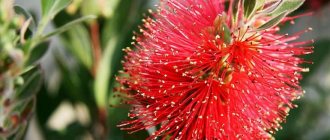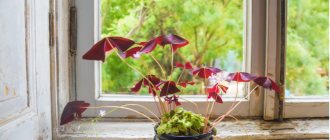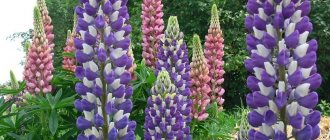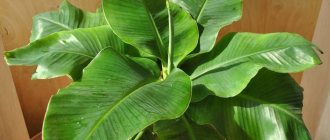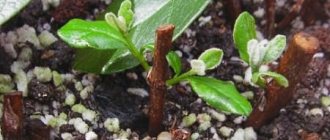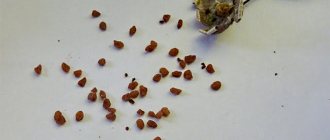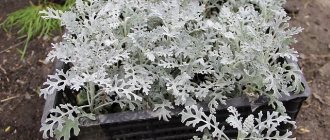Among the many bonsai and coniferous plants grown at home, eucalyptus stands out for its rarity and valuable qualities. This plant is highly valued by gardeners for its unusual foliage and crown, as well as for its unique aroma, which can completely change the atmosphere in the room. Moreover, this refers not only to the plant’s ability to release phytoncides into the air. Homemade eucalyptus can become the highlight of any interior. It has a spectacular appearance, but at the same time it is demanding in terms of care and maintenance conditions.
Caring for eucalyptus at home
This culture loves warmth and light, so you should think in advance about the location of the pots with seedlings. Until the plant gets stronger and actively develops, it is necessary to create the following conditions:
- temperature not less than 24 degrees Celsius;
- increased air humidity of at least 65% in winter, and 60% in summer.
To prevent the eucalyptus from getting sick, it is necessary to harden it.
To prevent the plant from getting sick, it is necessary to harden it.
This can be done in warm weather, but it is important to avoid drafts. In winter, the permissible temperature for keeping the plant is up to 16 degrees Celsius
Watering
Lemon eucalyptus loves moisture, but stagnation of water should not be allowed, as this can lead to rotting of the rhizome. You can place pots with young growth on a tray with drainage, and add water to it as it dries. Watering is done with settled warm water.
Lighting
The culture loves light and this must be taken into account when placing pots. The best growing zone is south, east and southeast. The lack of sunlight can be compensated by using fluorescent lamps.
In summer it is useful to expose eucalyptus to sunlight, but it is important to be careful not to cause a burn. The plant should be accustomed to natural sunlight gradually
Top dressing
The culture actively develops from spring to autumn, and winter is a dormant period. During this period, it is recommended to add organic matter and mineral fertilizers. Fertilizers are applied every 14-20 days, and stop in winter.
Eucalyptus replanting
A young plant up to three years old is replanted annually, choosing a pot accordingly. For adult cultures, the interval between procedures increases to 3 years.
An adult eucalyptus plant is replanted every three years.
Eucalyptus does not like to be transplanted, so extreme care must be taken. The best way is to carefully transfer it into a larger pot without destroying the root ball of earth.
When replanting adult plants, prune broken, rotten, or infected roots. The cut areas are treated with garden pitch or a weak copper-containing solution. Drainage is placed at the bottom of the container prepared for planting, and it is filled with loose soil, in the same composition as when planting the plant.
Trimming
When growing eucalyptus at home, it is important to control the growth of shoots. For these purposes, the main shoot is pruned in the spring, removing the main growth point at a height of one meter
After the procedure, the plant produces lush side shoots, and pinching should be done to form them.
Transfer
During the period of active growth, young eucalyptus requires an annual transplant. The most suitable time for this is spring, when new leaves are actively growing.
Note! Mature plants that are more than three years old are replanted every three years using the transshipment method.
The transplant is done as follows:
- Eucalyptus is watered in advance to make it easier to remove from the old pot.
- Prepare a larger pot.
- A drainage about 5 cm thick is made at the bottom of the container, and a small layer of earth is poured on top.
- The tree is removed from the previous pot, lightly shaking off the old soil from the roots.
- Inspect the entire root system, cutting off all damaged and rotten roots.
- The cut areas are sprinkled with charcoal or activated carbon.
- The plant is placed vertically in the pot and soil is added.
- Water with warm purified water.
An overgrown plant needs a new, spacious pot so that the roots do not suffer due to cramped space. After transplanting or planting, the plant goes through an adaptation period, so it should be removed away from bright sunlight and not fertilized for one week.
Transplantation by transshipment method
Description and distribution area
Eucalyptus (Eucalýptus) is a fairly large genus of evergreen representatives of the Myrtaceae family. It includes both trees and shrubs. The trunk of a plant can be straight or curved. There are often gum secretions on the surface. The crown can be different: from strict pyramidal to weeping.
Eucalyptus trees provide almost no shade. And all because their leaves are located differently from other plants - they stand edge-on. The shape of the leaf blades, depending on the plant variety, can be: ovoid, round, lanceolate, oblong. Eucalyptus flowers form inflorescences in the form of umbrellas or panicles. The fruit is a capsule. In most cases it is smooth, but sometimes it is furrowed, lumpy or ridged.
Most eucalyptus species grow in Australia, Tasmania, and New Zealand. This tree can be found in Indonesia, the islands of New Guinea and the Philippines. North of the equator, only one species grows wild - rainbow eucalyptus. On the territory of our country, this giant can grow under natural conditions only in the area of Sochi and the southern coast of Crimea.
Rules of care
Growing lemon eucalyptus or Gunn's eucalyptus at home is only half the battle, because then the plant requires attention and careful care. However, even with proper care, the likelihood that the tree will begin to bloom outside of natural conditions is small.
Watering
In spring, summer and autumn it requires abundant watering. It is necessary to constantly maintain soil moisture in the pot, while avoiding overwatering.
In winter, the amount of water should be reduced: add only when the top layer of soil becomes dry. You can place a tray with wet filler under the pot with the plant.
Important! Soil moisture must be monitored carefully at any time of the year, because too much water, as well as a lack of it, can lead to the upper part of the plant beginning to dry out.
Fertilizer
The plant needs feeding from spring to autumn every two weeks. The fertilizer should be complex, with a large amount of minerals and vitamins, as well as a low phosphorus content, since eucalyptus does not tolerate phosphorus fertilizers.
Trimming
Caring for eucalyptus at home also includes pruning the main trunk of the plant, which is done every year in the spring, so that the tree grows in height.
After pruning, the eucalyptus sends out young shoots, forming a wide bush. To make the crown of the tree more luxuriant, you can pinch these shoots.
If you want to limit the tree's growth or adapt it to a small container, you can trim the roots during replanting.
Did you know? Koalas feed on lemon eucalyptus leaves. The slowness of animals is attributed to the effects of essential oils contained in the leaves of this tree.
Transfer
Young eucalyptus plants should be replanted annually in the spring, when new leaves begin to appear and roots weave around the soil in the pot. Older trees need to be replanted every two years, since their growth is no longer as intense.
When replanting eucalyptus, it is important not to plant it too deep into the soil. The pot should be medium in size, so that the plant in it is neither cramped nor very spacious
Once the tree reaches a very large size, it can not be replanted, but simply change the top layer of soil.
Eucalyptus care and planting and care
Eucalyptus is an evergreen tree that any gardener will surely want to have on their yard. How to grow eucalyptus from seeds in the garden? Planting and care.
The best place to plant eucalyptus in the garden is where there is a lot of sun. Although this plant will feel very comfortable in the shade.
Planting a plant seed in open ground will not bring results. Initially, planting should be done at home:
- To plant seeds, you will need a clay pot with drainage placed at the bottom. Next will be soil with humus and sand.
- The seed needs to be sown in moist soil, pressing it down a little. For the first few days, eucalyptus does not need to be watered, and the air temperature should vary around 18°C.
- Within 7-10 days the first shoots will begin to appear. This moment is the most sensitive, since you need a lot of daylight and good ventilation. Otherwise, the sprouts may become moldy and die.
- After the sprouts have grown a little (up to 3 cm) and they already have several leaves, the eucalyptus should be replanted. For this you need a small container, 10 cm in diameter and 15 cm in height. After replanting, the soil should be well moistened.
The best place for eucalyptus to grow will be a windowsill on the sunny side.
During the warm period (spring, summer, autumn), eucalyptus needs to be watered very carefully, but in winter the moisture content can be significantly reduced. The plant needs feeding once every 14 days. To do this, you can use regular mineral fertilizers for indoor plants.
During the summer period, it is recommended to take the plant out onto the balcony or into the garden, where it will grow stronger and gain strength. But for the winter it should be taken indoors. The tree does not like spraying, but the dust still needs to be washed off once a month.
After 3-5 years, the eucalyptus will become cramped in the pot and will need to be transplanted into a tub. It needs to be replanted several times a year. Then the plant can be transplanted into open ground, after which it will no longer need replanting. The transplanted tree must be fertilized.
In spring, eucalyptus should undergo formative pruning or pinching of shoots. This procedure will restrain the growth of shoots, but will allow young leaves to grow.
If you want to have eucalyptus in your garden, you must first of all pay attention to which variety to choose. After all, not all types of plants can grow in open ground.
A plant such as indoor eucalyptus is known for releasing phytoncides. These special substances are able to destroy bacteria in the air, and a person will be able to feel that breathing has become much easier. This plant is also used to prepare remedies for various diseases of the respiratory tract and throat.
This plant is directly related to the myrtle family. It was first raised in Australia. Eucalyptus is a spectacular low, fairly compact tree that has a pyramidal shape. It is a slow growing plant and the foliage is an unusual green-blue color.
And older foliage has a more elongated shape, it is dense and does not have such a strong odor. Eucalyptus has a strong aroma because its leaves contain a large amount of essential oil. In nature, this plant grows up to 150 centimeters in height, while in indoor conditions it is much lower.
The flowers are single in structure, and the fruits are box-shaped.
Choosing a location and lighting
Eucalyptus loves light and sun. However, you should accustom him to the sun's rays gradually so that he adapts and does not get burned. The ideal place to place the tree is a south window or as close as possible to a west or east window.
In the summer, it is advisable to take the eucalyptus out to the balcony, veranda or garden. In winter, it is necessary to provide it with the brightest place in the house.
Eucalyptus is a fairly hardy tree and can withstand even light frosts. However, for indoor species in summer, the optimal temperature is from 20 to 25 °C, and in winter - not lower than 10 °C.
An odorous miracle - the aroma of lemon balm and lemon 2 in 1. How to grow and form a beautiful tree.
Hello, dear sadists and gardeners!
I have been growing plants relatively recently, but I can say that it is very exciting, especially when the result is pleasing to the eye. Therefore, this activity captivated me, especially since the world is full of amazing plants, such as our hero of the review.
I want to share with you my experience of growing such an unusual exotic plant as lemon eucalyptus from seeds. This indoor perennial plant has one distinctive feature - if you crush its leaves, a pleasant smell of lemon appears (with mint or lemon balm, as it seems to me - that's right! It's a mojito.), and it also blooms beautifully - with pleasant yellow hairy flowers.
Sowing
I purchased eucalyptus seeds on the website here. There is even my enthusiastic review about how high the germination rate of the seeds turned out to be. Seeds were bought if someone was interested in the process of growing this miracle from seeds.
I planted the seeds in February, and literally a few days later the first shoots appeared. 5 out of 6 have sprouted! I sowed the seeds in peat tablets. I didn’t expect such good germination, so I placed several seeds in one tablet.
Growth process
Subsequently, those plants that all three sprouted together in one tablet were transplanted into a pot with the same composition. Oddly enough, they turned out to be stronger and denser, and developed faster than the “loners”. Then I also put the single ones together and gave them to a friend. And the triple “mojito” stayed with me and moved to a more convenient and larger pot.
And now, in the fall, my eucalyptus looks like this:
Care and pruning
Caring for this plant is not very difficult; it seemed unpretentious to me. The plant loves the sun and grows actively if it does not lack sun. I have it sitting safely on the south window. However, eucalyptus requires watering much more often than other plants. It drinks very greedily; in the summer it needs to be watered daily. It is extremely undesirable to skip watering, otherwise it begins to droop the leaves, wither, and then the leaves turn yellow and fall off. The appearance begins to deteriorate.
I carried out pruning and shaping of the beautiful plant according to a self-invented and, one might say, intuitive form. Since by chance I had three plants growing in one pot, I decided not to separate them, but rather to make an advantage out of this disadvantage and braided their trunks))) While the plant trunks were young, flexible and pliable, this could be done easily and just. Here's what happened:
Over time, the trunks became thicker and covered with “wood”, and even grew a little together.
Three plants made a dense mini-tree. A single plant would not produce such beauty.
I pinch off the tops and unnecessary side shoots.
Top dressing
I once fed my eucalyptus tree with a regular solution of Gumat+7 fertilizer. Which, it seems to me, had a very beneficial effect on it - the growth and density of the plant accelerated. Side shoots appeared.
Benefit
Some facts about the plant
Thanks to the phytoncides released and the ability of the leaves to evaporate large amounts of water, eucalyptus helps improve indoor air quality. It has a beneficial effect on the psyche, helps with a runny nose, cough, and repels insects: flies, mosquitoes, mosquitoes.
As I already wrote, this variety of eucalyptus has a specific smell due to the high content of essential oils. I really like their scent. Even without all those beneficial properties, I’m just blown away by the smell of a leaf crushed in my hand. The plant is also pleasing to the eye from a purely aesthetic point of view.
Interesting things
➺ Eucalyptus leaves are covered with small “villi”
➺ You can easily overdo it with the smell. If you strongly interact with the leaves, for example when pruning a plant, such a strong aroma is released, to which my husband once said that it smells very sharply and strongly of a star.
➺ The plant really repels insects: before, my cacti were periodically tormented by spider mites, but now, in the vicinity of the eucalyptus, these guests do not visit us. And they will never touch the eucalyptus itself - it’s probably tasteless to them. There are no flies at all, and I don’t see any mosquitoes either.
➺A sufficient percentage of essential oils is contained in the dried leaves of the plant, so they are even added to teas.➺ Eucalyptus blooms in indoor conditions quite rarely. Which is very sad. I really hope that my favorite will please me with yellow furry creatures someday..
I will definitely update this review with new photos of my pet. So if you are interested, follow my review. Here is another review about another exotic - the beautiful Strelitzia, which six months ago became one of my favorites on the windowsill.
Home care for eucalyptus as a houseplant
Lemon eucalyptus care at home requires simple care. It consists of ensuring the correct temperature conditions, timely watering, applying the necessary fertilizing, annual replanting and periodic pruning.
Temperature
In summer, the most suitable temperature for eucalyptus is considered to be within 20-25 °C, in winter - 12-16 °C. The tree needs a fresh flow of air, but during the ventilation period in frosty weather it needs to be protected from cold drafts.
Lighting
It is best to place lemon eucalyptus in a pot at home in well-lit places, for example, it could be the windowsill of south, south-east or south-west windows. If all the windows of the apartment face north, it is necessary to use additional lighting, since a lack of light will lead to slow growth of the flower.
In summer, when the weather is good outside, the flower can be taken out onto the balcony or terrace. During heavy rain or wind, it must be taken back to the apartment. With the arrival of autumn, the tree must be returned to the room again.
Lush green bush
Watering
In summer, you need to make sure that the soil in the pot is always moist; you should water the plant once every 2-3 days with a small amount of water. In winter, eucalyptus needs to be watered as the top layer of soil dries out - once every 7-10 days.
Important! For irrigation, use only purified water at room temperature.
Eucalyptus plant species Populus
Humidity
In the summer, indoor eucalyptus needs moist air, but since the plant cannot be sprayed, you can maintain the required level of humidity by placing the pot in a pan of water. In this case, the tree will take as much water as it needs.
Priming
For proper development and good growth, eucalyptus must be planted in soil rich in mineral components. You can buy a ready-made substrate, or you can prepare it at home. The soil composition should include: humus (20%), turf (40%), river sand (20%) and dry peat (20%). The soil should be loose and well drained.
Feeding
During the active growing season, indoor eucalyptus must be fertilized periodically. Complex mineral fertilizers and organic matter can be used as fertilizers. Feeding should be done once every 14-20 days. Fertilizing is carried out immediately after watering. The amount of fertilizer applied is calculated according to the instructions.
Important! You should not fertilize the flower in winter during the dormant period. In addition, it is not recommended to fertilize immediately after transplantation, or if the flower is sick or infested with pests.
Reproduction
Eucalyptus cuttings take root with great difficulty, so it reproduces only by seeds . It is recommended to sow seeds in March or February in a substrate prepared in equal parts from sand and turf soil. It is necessary to plant 2 or 3 seeds in a pot with a drainage hole under the “greenhouse”, without covering it with soil.
By providing the seedlings with a temperature of 20 to 25 °C, you can expect germination within 3 weeks. Sometimes the first shoots may appear after 3 months. After the seedlings have a pair of true leaves, you can plant them one at a time in separate containers with a diameter of 7 cm.
Recommended soil composition for young eucalyptus trees:
- 1 part humus;
- 1 part of turf land;
- 1 part coarse river sand.
Ode to Eucalyptus
The first settlers who arrived on the Australian mainland at the beginning of the eighteenth century were amazed by the huge trees, over a hundred meters in height, with a luxurious crown, under which it was impossible to hide from the scorching sun. The leaves of this gigantic plant, the upper branches of which could easily look into the windows of the fiftieth floor, turn their side ribs towards the sun so that they do not form a shadow. And in their immediate environment there is not a single blood-sucking insect, because mosquitoes cannot stand the smell of eucalyptus.
The rainbow eucalyptus can be considered an amazing masterpiece of artistic creativity, painting its powerful trunk with all the colors of the rainbow, from the very ground to the sky. An adult tree can absorb about three hundred liters of water per day - this powerful pump can drain any swamp in a short time. Almost six hundred evergreen species of eucalyptus trees belonging to the myrtle family are known. With a specific smell, silvery, with a bluish tint and a waxy coating, its leaves are of particular value.
What does lemon eucalyptus look like and what family does it belong to?
Eucalyptus (from the Latin Eucalýptus) is an evergreen plant from the Myrtaceae family.
Lemon eucalite
Description of varieties of lemon eucalyptus
When growing eucalyptus at home, the most popular are 2 types:
- Lemon Eucalyptus;
- Gunn's eucalyptus.
Eucalyptus indoor Lemon came to us from Eastern Australia. At home, the height of decorative eucalyptus does not exceed 1 m. The leaves are bristly, have a yellow tint, reach 16 cm in length and are attached to the stem in a spiral. The light brown bark is reddish in places, even brown. Growths can be observed on its surface. Caring for this variety is easy.
Eucalyptus Lemon at home
Eucalyptus Gunna is native to Tasmania. It is easy to care for and can easily withstand dry air and low temperatures. The scales are clearly visible on the light orange bark. Oval leaves, sharp ends.
Ganna variety
A very interesting variety is the Rainbow Eucalyptus. What does it look like and what's interesting about it?
In nature, it grows in tropical forests. Not used in indoor floriculture. It can only be found in the botanical garden. Rainbow Eucalyptus requires a humid climate to grow successfully.
Interesting to know! It got its name due to the color of the bark. It shimmers with all the colors of the rainbow.
Variety: rainbow
Medicinal properties
In folk medicine, essential oil is used, as well as infusions and decoctions of eucalyptus. The benefits of the plant cannot be underestimated.
Medicinal properties:
- has a wound-healing, anti-inflammatory effect;
- relieves pain;
- strengthens the immune system;
- used for disease prevention;
- fights germs.
The presence of ozone is observed in eucalyptus essential oil. And thanks to this, the product has bactericidal properties. However, before using homemade eucalyptus, it is recommended to consult a doctor.
Briefly about the history of its appearance as a houseplant
Eucalyptus began to be grown as a houseplant due to its specific smell, which resembles a mixture of the aromas of verbena, thyme, lemon and mint.
Features of culture
Indoor eucalyptus is a small tree with a pyramid-shaped crown. It grows very slowly; a mature crop reaches a height of one hundred and fifty centimeters. The eucalyptus houseplant is slightly smaller in size.
The foliage has an unusual green color with a blue tint. The surface of the leaf plates is glossy and shimmers in the sun. In an indoor eucalyptus in a pot, you can notice changes in foliage that occur over time.
While young leaves have a soft texture and strong aroma, mature leaves become denser and less fragrant. The buds of the plant are formed one by one, after they wither, fruits appear in the form of boxes.
The aroma comes from the presence of essential oils. They are contained in the plant in huge quantities. In addition, in room conditions, eucalyptus releases substances called phytoncides. They have an antibacterial effect, purifying the air around us. In medicine, the plant is used in the manufacture of medicines used for diseases of the respiratory system.
Agrotechnical features
Not all species can be planted at home. Indoor eucalyptus Gunny and indoor eucalyptus Lemon are suitable for this purpose. In a specialized nursery you can purchase seedlings of these varieties or grow them from seeds. The second method is long, but the seeds have good germination.
It is best to plant planting material in clay pots. They contain sand and soil in equal proportions. Seeds are sown on moist soil. The pots are placed in a prepared place with a temperature of eighteen degrees Celsius.
Watering begins on the fifth day after sowing, when the first shoots hatch. When they reach a height of three centimeters, a pick is made. Watering also begins on the fifth day. The seedlings can be placed in a permanent place in the pot after twenty days.
Medicinal properties
Eucalyptus growing at home has the same medicinal properties as its counterparts in the wild. The main medicinal raw material of this tree is the leaves, from which essential eucalyptus oil is obtained in large quantities. Even dry Eucalyptus has medicinal properties: infusions, tinctures and decoctions are prepared from it, inhalations with eucalyptus leaves are made at home, which helps cure laryngitis, tracheitis, bronchitis and even pleurisy. As a disinfectant, the oil is used to wash infectious wounds and ulcers. Treatment with Eucalyptus preparations has proven itself well for purulent mastitis, open fractures, chronic osteomyelitis and other similar diseases.
For tonsillitis, pharyngitis and sore throat, you can gargle with an infusion of eucalyptus leaves. To prepare an infusion of Eucalyptus, grind 10 g of dry leaves, brew a glass of boiling water like tea, and then keep in a water bath over low heat for an hour, without bringing to a boil. The prepared infusion should be used within two days. It can also be used internally - three times a day, one tablespoon.
To prepare eucalyptus tincture, fresh leaves, vodka and sugar are used. Place washed, finely chopped leaves into a dark glass bottle, filling it by a third. Then half of it is covered with sugar, covered with gauze and kept in a dark place for three to four days. After aging, the resulting syrup is poured with vodka, shaken thoroughly and left for another week. After aging, the leaves are squeezed out and thrown away, the tincture is filtered and poured into a dark glass bottle for storage. Use eucalyptus tincture in the amount of twenty to thirty drops, diluted in a glass of warm boiled water three times a day. The resulting drug is also used for rubbing, lotions, and rinsing in the fight against various skin diseases. This tincture is used to treat sore throat, stomatitis, loose stools, enterocolitis, as well as to combat severe bleeding.
Eucalyptus essential oil has deodorizing properties, so it has been used for many years in the manufacture of dry perfumes and as part of aromatic pads - sachets. At home, Eucalyptus oil can be used to repel insects: mosquitoes, mosquitoes and other species.
Possible problems during cultivation
Improper care can cause disease and even death of the plant. If the process of caring for eucalyptus is disrupted, the following problems may appear:
- in case of insufficient lighting, the stems will become very tall, the leaves will decrease in size and change their color to a less saturated color. To solve the problem, it is necessary to move the flower to a more illuminated place or organize additional lighting, especially in winter, when daylight hours are short. It is also worth doing in the summer in cloudy weather;
- If there is insufficient watering, the leaves on the eucalyptus will dry out and fall off. In this case, it is necessary to adjust the watering regime;
- direct sunlight on the leaves and insufficient watering can cause burns. During the midday heat, it is worth shading eucalyptus and moisturizing it in a timely manner;
- Excessive moisture can lead to stagnation of water in the soil, rotting of the root system, softness and falling leaves.
Diseases and pests
Like most essential oil plants, the indoor eucalyptus flower is almost not attacked by harmful insects. It is very rare to find spider mites or any type of aphid on it. In this case, isolate the indoor eucalyptus in a pot from the rest of the indoor flowers and apply the insecticide in two or three doses with an interval of several days.
Any changes in the appearance of the Eucalyptus indoor plant usually indicate discomfort experienced:
- Due to lack of light, the shoots become elongated, and the leaves become smaller and turn pale.
- Withering and falling leaves indicate a lack of moisture; the volume or frequency of watering should be increased.
- Spots on the leaves may indicate sunburn; in the summer months, the plant should be slightly shaded during the daytime.
- When the earthen ball becomes waterlogged, the roots begin to rot and the leaves lose their original elasticity.
Thanks to its antiseptic properties, eucalyptus is not prone to diseases and pest attacks.
However, improper care can lead to the appearance of uninvited guests in the form of scale insects and spider mites. If insects are found, remove them with a damp sponge and treat the plant with insecticides.
Diseases and pests
Due to the high content of phytoncides, lemon eucalyptus is highly resistant to various types of diseases. Also, because of the smell, many pests avoid it. But if the care rules are not followed, spider mites or scale insects may appear. You can fight them with a damp sponge dipped in soapy water. If such actions do not lead to anything, you need to treat the plant with insecticides.
Lemon eucalyptus is a fragrant evergreen that is great for indoor growing and requires little care. It is easy to grow eucalyptus at home, because the rules of care are extremely simple. This flower can create a pleasant aroma in the room and purify the air, as well as quickly cure winter colds.
Difficulties in the growing process
In the process of growing eucalyptus, almost every gardener may encounter certain problems. The main problems are: stretching of shoots, rather dull foliage color, significant reduction in plant size. All this can happen due to the fact that there is not enough light for eucalyptus to grow.
An equally common problem is wilting of foliage as a result of insufficient watering. The root system also requires a lot of attention and care.
Indoor lemon eucalyptus is a rather finicky plant, and if you really want to grow it, you must carefully study all the nuances and rules for caring for it.
Growing lemon eucalyptus from seeds
The culture can be propagated by cuttings and seed method. The permissible sowing time is quite long: from mid-February to the end of June. But planting from the third ten days of February to the second ten days of April is considered optimal.
For cultivation, you should use turf soil with sand in equal proportions, which must be prepared in advance. For sowing, use standard containers with drainage, such as ordinary flower pots, or cups for seedlings with stands.
Seeds are planted to a depth of 5 millimeters, 2-3 pieces per container. After sowing, it is recommended to cover the pots with plastic wrap or a bag - this will help retain moisture in the soil. Check the soil surface daily and moisten when dry.
Eucalyptus seeds germinate quite quickly, but provided that the room temperature is kept between 23-25 degrees Celsius. The first shoots can be noticed within a week after sowing, but pipping can take up to three months.
This plant needs picking. It is performed when the first 2 true leaves appear. Seedlings are planted one at a time in a container with a diameter of 7 centimeters. Before planting, prepare the soil by mixing turf soil, humus and sand in a one to one ratio.
Varieties suitable for home cultivation
How to grow a lemon tree from a seed at home
There are many types of eucalyptus (more than 500), but only a few of them are suitable for growing as an ornamental crop. The most popular include:
- globular. It stands out for its beautiful, pyramidal crown and bluish-blue leaves, on the outside of which there is a silvery coating;
- Gunny. Young plants have round, gray-green leaves, which become oblong with a pointed tip as the tree matures;
- Blue baby. Belongs to the dwarf species of eucalyptus. Distinguished by small gray-blue petals;
- fig leaf. It stands out among other varieties due to its rounded small leaves;
- silver or ash. The main difference is the gray oval or round leaves;
- Populus is an ornamental eucalyptus that is capable of forming small berries.
Important! These varieties are not intended for planting in open ground; they can only be grown indoors. There is also a very beautiful species - rainbow eucalyptus, which has bark of various colors similar to the rainbow, but it is not suitable for growing as a houseplant
There is also a very beautiful species, the rainbow eucalyptus, which has bark of various colors similar to a rainbow, but it is not suitable for growing as a houseplant.
Varieties of plants in pots on the windowsill
Plant species
Of the more than 700 different types of eucalyptus, about 60 are suitable for growing at home. The following varieties are most popular among gardeners:
- globular;
- ashen;
- gunny;
- citric.
Eucalyptus globulus or globular eucalyptus, according to many gardeners, is one of the most beautiful plants that can be grown in pots on the windowsill of a city apartment. Its crown has a pyramidal shape, and its silver-blue leaves are covered with a thin waxy coating.
Ash eucalyptus is also called silver eucalyptus. It may have received this name because when its gray leaves dry out, they look like silver coins.
Eucalyptus gunni leaves change shape as they mature. When young, they are round, but as they get older, the leaf blade lengthens. This variety, unlike others, does not have the characteristic odor inherent in other eucalyptus trees.
Lemon eucalyptus is very fragrant. Its smell is a bit like lemon. The leaves of the plant are light green with speckles.
In addition, you can grow no less beautiful dwarf varieties in a flower pot: Blue baby, Azura, populus, rainbow, etc.
Growing eucalyptus from seeds
Eucalyptus can be grown at home, its size is much more modest, the plants reach 1-2 meters.
All the beneficial properties that a large tree has are inherent in a small or domestic eucalyptus.
It can only be grown from seeds. The seeds are quite tiny, reminiscent of buckwheat only even smaller.
Fresh seeds germinate almost perfectly, but the plant does not take cuttings well.
It is better to take a plastic pot (elastic), when the plant sprouts, the pot with soil can be easily crushed (as if to soften the soil) and calmly remove the sprout without injuring the root.
Be sure to put about a quarter of the pot drainage at the bottom. Cover the top with soil.
You can use a universal one; eucalyptus is not fussy in this regard. We press the earth a little.
I advise you to put 1 - 2 seeds in one medium pot. They need to be pressed into the soil 0.5 cm.
After planting, there is no need to water, just moisten the top layer of soil with a spray bottle
It is important that the seeds do not fester.
Now the eucalyptus seeds need to build a greenhouse. You can cover with cling film or place a cut plastic bottle.
A plastic bottle is very convenient, because you can always unscrew the cap on it to ventilate or add a little moisture.
Eucalyptus seeds germinate very quickly, anywhere from 7 to 10 days. The greenhouse should be placed in a warm place.
Eucalyptus seedlings resemble radish seedlings in appearance (slightly of a beet color).
When 1 - 2 true leaves grow on the seedlings, the seedlings dive to a permanent place. After picking, they need to be placed on the window so that there is enough light.
Now a very important point: As soon as our leaves begin to grow, we must not regret pinching our plant.
When the eucalyptus reaches 7 cm, we do the obligatory pinching so that the plant does not stretch, otherwise it will stretch thin with a couple of branches on the top.
Watering eucalyptus
The most important point in caring for this tree is watering. It is a large water-drinker; watering is required constant and abundant from spring to autumn, and only moderate in winter.
We water only when the top 3 - 4 cm layer of soil has dried, and immediately remove excess water from the pan.
Under no circumstances should the earthen clod be allowed to dry out completely; the eucalyptus may die.
Does not require spraying leaves. It is advisable to replant once a year.
Eucalyptus lighting
Loves good lighting. In summer it feels good outside, so it is advisable to take it out to the balcony with a constantly open window.
Possible growing problems
- Overdrying of the earthen coma leads to the shedding of leaves (leaves are not restored)
- Cold drafts are contraindicated. There is also loss of foliage.
- Stagnation of water in the soil. Good drainage is needed, and immediately remove the water from the pan.
- If the air is dry, spider mites may appear. The leaves turn yellow and there may be cobwebs on the inside of the leaves. In this case, you need to take the garlic (in gruel), put it in a small container, and then place it in a pot next to the plant. Cover the entire plant with a plastic bag and leave it there for a day. Garlic will help eucalyptus with its phytoncides.
How to propagate yourself
You can grow lemon eucalyptus from seeds, as well as by rooting apical cuttings.
Germination of seeds
How to grow lemon eucalyptus using seeds:
- Place a drainage layer on the bottom of the planting container and soil on top.
- Pour lemon eucalyptus seeds Ozone, lightly pressing them into the ground, water with warm water.
- Cover the container with glass or film and place in a warm place for germination.
- Every day, plantings need to be ventilated, removing the cover and removing accumulated condensation.
- The first shoots can be seen after 7-10 days. When the first shoots hatch, the cover must be removed.
- When 3-4 true leaves appear, pick them out in separate small pots.
- When the young plants grow to a height of 15-20 cm, transplant them into a large pot.
Grown seedling
Rooting cuttings
Step-by-step process of rooting cuttings:
- From an adult plant, several young shoots 10-12 cm long are cut off, and all side leaves are removed.
- The cut is treated with a root growth stimulator.
- The sprouts are planted in prepared soil.
- Cover with film and place in a warm place.
- Rooting will take 3-4 weeks.
- When the cutting takes small roots, it is transplanted to a permanent place.
Beneficial properties of indoor eucalyptus
Eucalyptus is a home plant that is often used to treat abscesses, furunculosis, purulent mastitis and various ulcers. Decoctions of eucalyptus leaves can be used for inhalation for acute respiratory infections and gargling for throat diseases and various problems in the oral cavity.
As mentioned earlier, eucalyptus contains an essential oil, the main constituent of which is cineole (eucalyptol). Oil, tinctures and infusions are prepared from the plant, which have bactericidal, antiseptic and antiviral effects.
Phytoncides released by eucalyptus help clean the air from pathogenic bacteria and microbes. In order to effectively clean the room, it is enough to place one tree in the room.
By rubbing a few eucalyptus leaves in your hands and inhaling the aroma, you can prevent colds
It should be taken into account that chewing the leaves and eating them can cause poisoning.
The uniqueness of the plant also lies in the fact that it is able to repel annoying insects such as flies and mosquitoes.
The leaves contain essential oil that has powerful antibacterial and antiviral properties. The leaves of the plant are used to prepare oils, infusions and alcohol tinctures.
Uses of lemon eucalyptus
Oils contained in large quantities in the foliage of the plant are successfully used in medicine and cosmetology. It has disinfectant, astringent and bactericidal properties.
Up to 3% of essential oils are contained even in the dried leaves of the plant, which is why they are added to teas. For medicinal purposes, eucalyptus leaves are used to prepare decoctions and infusions.
Lemon eucalyptus oils alleviate pain in respiratory diseases, so they are added to inhalation products. Preparations containing essential oils are used to treat cervical erosion, herpes, and fungi.
Substances contained in plant fiber have high disinfecting properties. Medicines based on eucalyptus are used to relieve pain from lumbago, rheumatism, and neuralgia.
Due to its deodorizing properties, the oil is used in the manufacture of flavoring sachets. Also, the aroma, pleasant to human perception, is destructive to insects, so eucalyptus oil is used as a means to combat ants, mosquitoes and other sucking pests.
